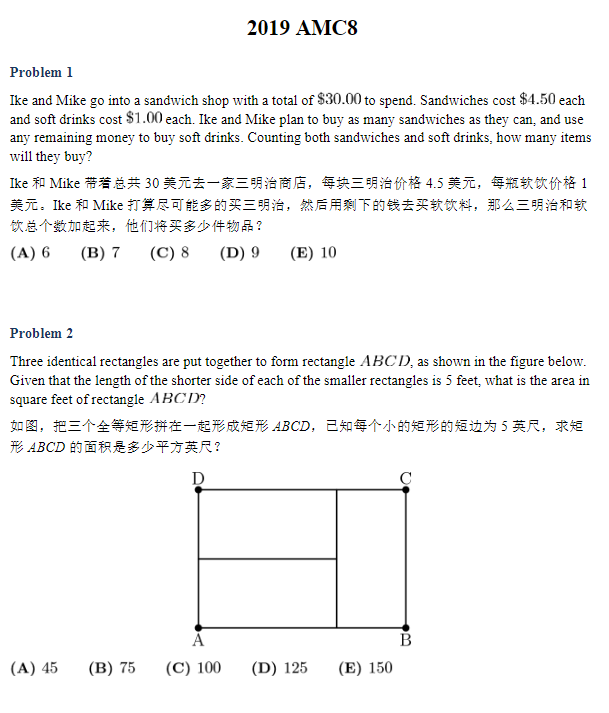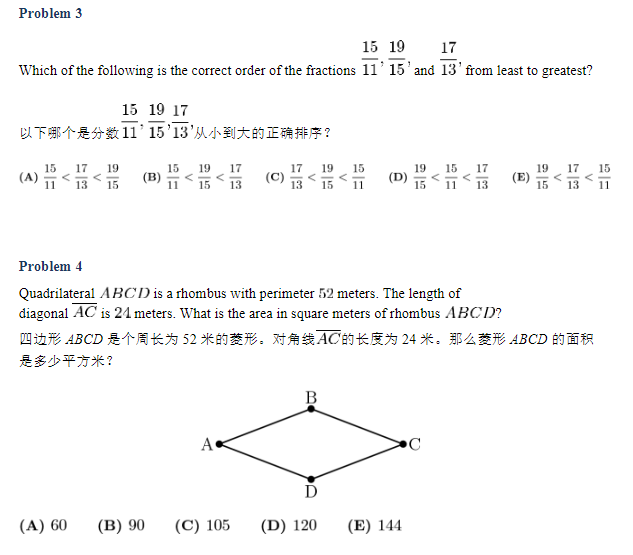2019年AMC 8 真题:
Problem 1
Ike and Mike go into a sandwich shop with a total of ![]() to spend. Sandwiches cost
to spend. Sandwiches cost ![]() each and soft drinks cost
each and soft drinks cost ![]() each. Ike and Mike plan to buy as many sandwiches as they can, and use any remaining money to buy soft drinks. Counting both sandwiches and soft drinks, how many items will they buy?
each. Ike and Mike plan to buy as many sandwiches as they can, and use any remaining money to buy soft drinks. Counting both sandwiches and soft drinks, how many items will they buy?
![]()
Problem 2
Three identical rectangles are put together to form rectangle ![]() , as shown in the figure below. Given that the length of the shorter side of each of the smaller rectangles is 5 feet, what is the area in square feet of rectangle
, as shown in the figure below. Given that the length of the shorter side of each of the smaller rectangles is 5 feet, what is the area in square feet of rectangle ![]() ?
?
![[asy] draw((0,0)--(3,0)); draw((0,0)--(0,2)); draw((0,2)--(3,2)); draw((3,2)--(3,0)); dot((0,0)); dot((0,2)); dot((3,0)); dot((3,2)); draw((2,0)--(2,2)); draw((0,1)--(2,1)); label("A",(0,0),S); label("B",(3,0),S); label("C",(3,2),N); label("D",(0,2),N); [/asy]](https://latex.artofproblemsolving.com/e/0/7/e0752885e3cff488bd89893347c595b7c570d339.png)
![]()
Problem 3
Which of the following is the correct order of the fractions ![]() and
and ![]() from least to greatest?
from least to greatest?
![]()
Problem 4
Quadrilateral ![]() is a rhombus with perimeter
is a rhombus with perimeter ![]() meters. The length of diagonal
meters. The length of diagonal ![]() is
is ![]() meters. What is the area in square meters of rhombus
meters. What is the area in square meters of rhombus ![]() ?
?
![[asy] draw((-13,0)--(0,5)); draw((0,5)--(13,0)); draw((13,0)--(0,-5)); draw((0,-5)--(-13,0)); dot((-13,0)); dot((0,5)); dot((13,0)); dot((0,-5)); label("A",(-13,0),W); label("B",(0,5),N); label("C",(13,0),E); label("D",(0,-5),S); [/asy]](https://latex.artofproblemsolving.com/e/5/4/e54b35c6e9f6a1eaa16a3138ed06ebc73122be63.png)
![]()
Problem 5
A tortoise challenges a hare to a race. The hare eagerly agrees and quickly runs ahead, leaving the slow-moving tortoise behind. Confident that he will win, the hare stops to take a nap. Meanwhile, the tortoise walks at a slow steady pace for the entire race. The hare awakes and runs to the finish line, only to find the tortoise already there. Which of the following graphs matches the description of the race, showing the distance ![]() traveled by the two animals over time
traveled by the two animals over time ![]() from start to finish?
from start to finish?![[asy] unitsize(0.4 cm); pair transx, transy; int i, j; int x, y; transx = (13,0); transy = (0,-9); for (i = 0; i <= 2; ++i) { for (j = 0; j <= 1; ++j) { if (i <= 1 || j <= 0) { for (x = 1; x <= 10; ++x) { draw(shift(i*transx + j*transy)*((x,0)--(x,5)),gray(0.7) + dashed); } for (y = 1; y <= 5; ++y) { draw(shift(i*transx + j*transy)*((0,y)--(10,y)),gray(0.7) + dashed); } draw(shift(i*transx + j*transy)*((0,0)--(11,0)),Arrow(6)); draw(shift(i*transx + j*transy)*((0,0)--(0,6)),Arrow(6)); label("time", (5,-0.5) + i*transx + j*transy); label(rotate(90)*"distance", (-0.5,2.5) + i*transx + j*transy); } }} draw((0,0)--(1.5,2.5)--(7.5,2.5)--(9,5),linewidth(1.5*bp)); draw((0,0)--(10,5),linewidth(1.5*bp)); draw(shift(transx)*((0,0)--(2.5,2.5)--(7.5,2.5)--(10,5)),linewidth(1.5*bp)); draw(shift(transx)*((0,0)--(9,5)),linewidth(1.5*bp)); draw(shift(2*transx)*((0,0)--(2.5,3)--(7,2)--(10,5)),linewidth(1.5*bp)); draw(shift(2*transx)*((0,0)--(9,5)),linewidth(1.5*bp)); draw(shift(transy)*((0,0)--(2.5,2.5)--(6.5,2.5)--(9,5)),linewidth(1.5*bp)); draw(shift(transy)*((0,0)--(7.5,2)--(10,5)),linewidth(1.5*bp)); draw(shift(transx + transy)*((0,0)--(2.5,2)--(7.5,3)--(10,5)),linewidth(1.5*bp)); draw(shift(transx + transy)*((0,0)--(9,5)),linewidth(1.5*bp)); label("(A)", (-1,6)); label("(B)", (-1,6) + transx); label("(C)", (-1,6) + 2*transx); label("(D)", (-1,6) + transy); label("(E)", (-1,6) + transx + transy); [/asy]](https://latex.artofproblemsolving.com/0/4/d/04decf8a6bb68bcc53035413d5d5750870605b11.png)
Problem 6
There are ![]() grid points (uniformly spaced) in the square shown in the diagram below, including the points on the edges. Point
grid points (uniformly spaced) in the square shown in the diagram below, including the points on the edges. Point ![]() is in the center of the square. Given that point
is in the center of the square. Given that point ![]() is randomly chosen among the other
is randomly chosen among the other ![]() points, what is the probability that the line
points, what is the probability that the line ![]() is a line of symmetry for the square?
is a line of symmetry for the square?
![[asy] draw((0,0)--(0,8)); draw((0,8)--(8,8)); draw((8,8)--(8,0)); draw((8,0)--(0,0)); dot((0,0)); dot((0,1)); dot((0,2)); dot((0,3)); dot((0,4)); dot((0,5)); dot((0,6)); dot((0,7)); dot((0,8)); dot((1,0)); dot((1,1)); dot((1,2)); dot((1,3)); dot((1,4)); dot((1,5)); dot((1,6)); dot((1,7)); dot((1,8)); dot((2,0)); dot((2,1)); dot((2,2)); dot((2,3)); dot((2,4)); dot((2,5)); dot((2,6)); dot((2,7)); dot((2,8)); dot((3,0)); dot((3,1)); dot((3,2)); dot((3,3)); dot((3,4)); dot((3,5)); dot((3,6)); dot((3,7)); dot((3,8)); dot((4,0)); dot((4,1)); dot((4,2)); dot((4,3)); dot((4,4)); dot((4,5)); dot((4,6)); dot((4,7)); dot((4,8)); dot((5,0)); dot((5,1)); dot((5,2)); dot((5,3)); dot((5,4)); dot((5,5)); dot((5,6)); dot((5,7)); dot((5,8)); dot((6,0)); dot((6,1)); dot((6,2)); dot((6,3)); dot((6,4)); dot((6,5)); dot((6,6)); dot((6,7)); dot((6,8)); dot((7,0)); dot((7,1)); dot((7,2)); dot((7,3)); dot((7,4)); dot((7,5)); dot((7,6)); dot((7,7)); dot((7,8)); dot((8,0)); dot((8,1)); dot((8,2)); dot((8,3)); dot((8,4)); dot((8,5)); dot((8,6)); dot((8,7)); dot((8,8)); label("P",(4,4),NE); [/asy]](https://latex.artofproblemsolving.com/2/e/f/2ef50880b9e105fcb40568742659a26c359c6c1a.png)
![]()
以下是我们为您整理的中英双语真题试卷,还有全英版真题供您选择
扫码即可免费领取完整版:



更多AMC 8 历年真题+真题详解
扫码添加顾问即可免费领取

